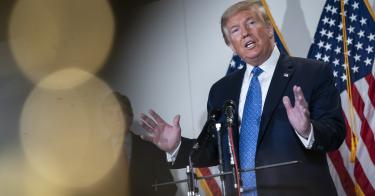Many Americans seem to believe the president should be the country’s Principal Public Health Officer, or even Oracle in Chief. Maybe this is because the U.S. relies so much on the executive branch to make government work, or because in times of crisis the president is the natural focus for Americans’ anxieties. Whatever the reason, it’s new. History reveals that presidents have responded to past epidemics with, well, not much at all.
Take the yellow fever epidemic of 1793, which struck Philadelphia, then the U.S. capital, with particular violence. Beginning in the city’s poor wards, the virus took only two months to kill 5,000 of the city’s 21,000 inhabitants, with the death toll topping 100 a day in mid-October. Thousands attempted to flee the city, only to be turned back by vigilantes and militia.
What did President Washington do? He left Philadelphia on Sept. 10, 1793, and headed for Mount Vernon, where he stayed in comparative safety until the epidemic’s curve had flattened, returning on Nov. 10.
Meanwhile, for two months the federal government stopped operating; even the post office ceased deliveries. Real leadership fell to Philadelphia’s mayor, Matthew Clarkson, who reported daily to his office, and with the help of African-American leaders such as Absalom Jones and Richard Allen, struggled to keep the city’s streets clean and clear.
A genuine pandemic hit the U.S. in 1832, when trade carried cholera from India to Europe and then North America. Cholera is caused by intestinal bacteria, and its path through Europe was lethal. Out of Berlin’s 240,000 inhabitants, 2,220 were sickened and 1,401 died; in Vienna, 3,980 out of 300,000 were stricken, and 1,899 died.
New York Mayor Walter Bowne quarantined shipping on Feb. 2, 1832. But cholera surfaced there anyway on June 27, and by the beginning of September it was causing 178 deaths a week. When the outbreak ended in mid-October, 3,471 New Yorkers, out of 250,000, had been killed by cholera; Philadelphia saw 935 deaths from 2,314 cases.
And what did President Jackson do? Nothing. He left Washington for Tennessee, urging his extended family and advisers to do likewise. Even Sen. Henry Clay, Jackson’s political rival, couldn’t goad the president into action. Clay proposed a congressional resolution calling for a national day of fasting and prayer, but the president refused to issue his own statement, wary of “transcending the limits prescribed by the Constitution for the president,” as he put it.
The so-called Spanish flu hit the U.S. in 1918 as an unprecedented shock. This H1N1 virus was probably brought to Europe from China, according to historian Mark Humphries, by laborers recruited to fill home-front jobs in a Europe torn by World War I. It struck the U.S. amid wartime mobilization and eventually killed 675,000 Americans. On a single day in October 1918, 202 died in Boston; in Philadelphia, 4,500 died in one week, 837 on Oct. 12 alone. In Washington, churches closed and Congress and the Supreme Court adjourned.
By 1918 the federal government had more public-health resources to deploy than in the previous century, beginning with the newly reorganized U.S. Public Health Service, which recruited 1,000 doctors and more than 700 nurses to fight the epidemic. But so much of the country’s health infrastructure had been swept into the war effort that again most of the burden fell on local authorities. New York City Health Commissioner Royal S. Copeland ordered businesses to open on staggered shifts to reduce subway usage, imposed a port quarantine and required the placarding of homes with flu victims.
President Wilson made no public statements about the Spanish flu, and in January 1919 he left the U.S. for France, where he hoped to manage the Versailles peace negotiations. He didn’t manage them very well, but he did come down with the Spanish flu himself on April 3, suffering a fever of 103 degrees. Cary Grayson, Wilson’s doctor, described how the president was “seized with violent paroxysms of coughing, which were so severe and frequent that it interfered with his breathing.”
There’s one exception to this dismal record of inaction, from a president who didn’t face a similar U.S. epidemic: George W. Bush. Alarmed by his reading of John M. Barry’s history of the Spanish flu, “The Great Influenza,” Mr. Bush ordered the creation in 2005 of a National Strategy for Pandemic Influenza to ensure stockpiles of “everything from syringes to hospital beds, respirators, masks and protective equipment.”
Some have criticized President Trump’s response to COVID-19 as too little, too late. But Mr. Trump has imposed travel restrictions, convened a national response strategy, and demanded cooperation from both the public and private sectors. That’s substantially more than Washington, Jackson or Wilson did in the hour of health crisis.
Presidents are rarely elected for their expertise in public health. And the U.S. Constitution ensures that power, rather than being concentrated in one man’s hands, is dispersed horizontally across branches of government and vertically between Washington and the states. But the more globalized the economy, the higher the likelihood of pandemics—and the more Americans will come to expect from presidents, whether as oracles or planners.
This piece originally appeared in the Wall Street Journal on 4/26/2020



